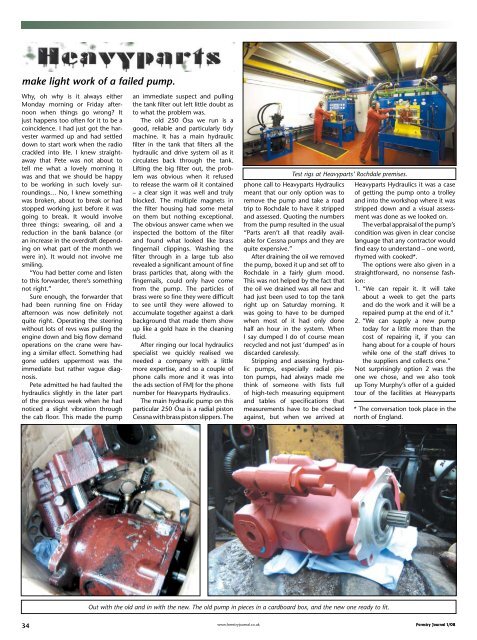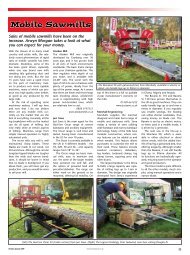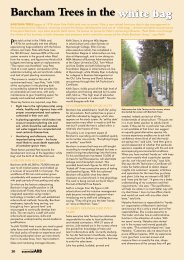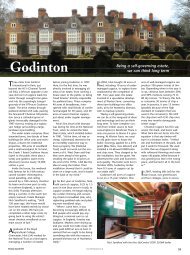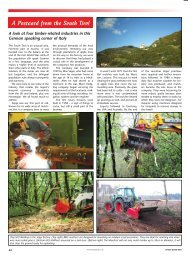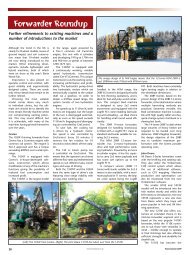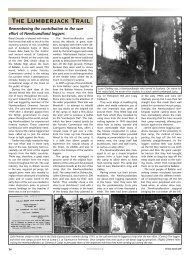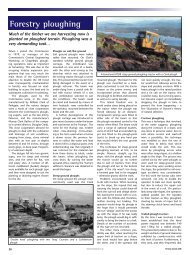Heavyparts Hydraulics - Forestry Journal
Heavyparts Hydraulics - Forestry Journal
Heavyparts Hydraulics - Forestry Journal
- No tags were found...
Create successful ePaper yourself
Turn your PDF publications into a flip-book with our unique Google optimized e-Paper software.
make light work of a failed pump.Why, oh why is it always eitherMonday morning or Friday afternoonwhen things go wrong? Itjust happens too often for it to be acoincidence. I had just got the harvesterwarmed up and had settleddown to start work when the radiocrackled into life. I knew straightawaythat Pete was not about totell me what a lovely morning itwas and that we should be happyto be working in such lovely surroundings…No, I knew somethingwas broken, about to break or hadstopped working just before it wasgoing to break. It would involvethree things: swearing, oil and areduction in the bank balance (oran increase in the overdraft dependingon what part of the month wewere in). It would not involve mesmiling.“You had better come and listento this forwarder, there’s somethingnot right.”Sure enough, the forwarder thathad been running fine on Fridayafternoon was now definitely notquite right. Operating the steeringwithout lots of revs was pulling theengine down and big flow demandoperations on the crane were havinga similar effect. Something hadgone udders uppermost was theimmediate but rather vague diagnosis.Pete admitted he had faulted thehydraulics slightly in the later partof the previous week when he hadnoticed a slight vibration throughthe cab floor. This made the pumpan immediate suspect and pullingthe tank filter out left little doubt asto what the problem was.The old 250 Ösa we run is agood, reliable and particularly tidymachine. It has a main hydraulicfilter in the tank that filters all thehydraulic and drive system oil as itcirculates back through the tank.Lifting the big filter out, the problemwas obvious when it refusedto release the warm oil it contained– a clear sign it was well and trulyblocked. The multiple magnets inthe filter housing had some metalon them but nothing exceptional.The obvious answer came when weinspected the bottom of the filterand found what looked like brassfingernail clippings. Washing thefilter through in a large tub alsorevealed a significant amount of finebrass particles that, along with thefingernails, could only have comefrom the pump. The particles ofbrass were so fine they were difficultto see until they were allowed toaccumulate together against a darkbackground that made them showup like a gold haze in the cleaningfluid.After ringing our local hydraulicsspecialist we quickly realised weneeded a company with a littlemore expertise, and so a couple ofphone calls more and it was intothe ads section of FMJ for the phonenumber for <strong>Heavyparts</strong> <strong>Hydraulics</strong>.The main hydraulic pump on thisparticular 250 Ösa is a radial pistonCessna with brass piston slippers. TheTest rigs at <strong>Heavyparts</strong>’ Rochdale premises.phone call to <strong>Heavyparts</strong> <strong>Hydraulics</strong>meant that our only option was toremove the pump and take a roadtrip to Rochdale to have it strippedand assessed. Quoting the numbersfrom the pump resulted in the usual“Parts aren’t all that readily availablefor Cessna pumps and they arequite expensive.”After draining the oil we removedthe pump, boxed it up and set off toRochdale in a fairly glum mood.This was not helped by the fact thatthe oil we drained was all new andhad just been used to top the tankright up on Saturday morning. Itwas going to have to be dumpedwhen most of it had only donehalf an hour in the system. WhenI say dumped I do of course meanrecycled and not just ‘dumped’ as indiscarded carelessly.Stripping and assessing hydraulicpumps, especially radial pistonpumps, had always made methink of someone with fists fullof high-tech measuring equipmentand tables of specifications thatmeasurements have to be checkedagainst, but when we arrived at<strong>Heavyparts</strong> <strong>Hydraulics</strong> it was a caseof getting the pump onto a trolleyand into the workshop where it wasstripped down and a visual assessmentwas done as we looked on.The verbal appraisal of the pump’scondition was given in clear conciselanguage that any contractor wouldfind easy to understand – one word,rhymed with cooked*.The options were also given in astraightforward, no nonsense fashion:1. “We can repair it. It will takeabout a week to get the partsand do the work and it will be arepaired pump at the end of it.”2. “We can supply a new pumptoday for a little more than thecost of repairing it, if you canhang about for a couple of hourswhile one of the staff drives tothe suppliers and collects one.”Not surprisingly option 2 was theone we chose, and we also tookup Tony Murphy’s offer of a guidedtour of the facilities at <strong>Heavyparts</strong>* The conversation took place in thenorth of England.Out with the old and in with the new. The old pump in pieces in a cardboard box, and the new one ready to fit.34www.forestryjournal.co.uk<strong>Forestry</strong> <strong>Journal</strong> 1/08
while we waited.In between we had a lesson inwhy the pump we had broughtdown had failed. The most likelycause was that at some time it hadbeen run short of oil which doesn’tnecessarily mean someone had letthe tank run dry. Some machineslike the Ösa have a large hose fromthe tank to the pump and this hoseshould be semi-rigid, usually with awire coil built into its walls, like thevacuum pipe on a slurry tanker. Thisstops it collapsing if the pump startsto pull oil from the tank, rather thangravity allowing oil to flow freely.It also prevents it from kinking onmachines where the oil tank liftsup and down when the cab tilts orswings out to provide access. It isan unfortunate fact that if this pipeneeds replacing at some time, itmight just be changed for a hosethat is the correct size but not thecorrect type. The machine will workfine until everything gets hot. Thenthe pipe goes soft and collapses,reducing oil flow, which makes theproblem worse as the pump pullsharder to get some oil, and, if it isbeing starved, the damage beginsto accumulate.I had been impressed with theattitude of <strong>Heavyparts</strong> <strong>Hydraulics</strong>staff right from the first phone callwhen I had described the pump andread out the part number, and hadreceived an almost instant decisionas to its manufacturer and type,both of which had proved accurate.This was all the more impressiveconsidering I had never dealt withthe company before.The tour around the almost surgicallyclean workshops only addedfurther to the feeling of confidencein the company. We then went intothe test area and were confrontedwith the motive force for the testrigs – two Rolls Royce Perkins dieselsin their own custom-built facilitywith cooling fans and huge exhaustextractors, together with substantialsound protection. The two 300+bhp engines power an incrediblysophisticated set of computer-controlledtest rigs that can test pumpsand motors separately, or can link apump to its own, or a suitable, drivemotor to test them under workingconditions for instant results. Theycan even apply varying loads torecreate the rigours of under stressworking conditions.Whatever the fault with a hydraulicpump or motor, and however bigor small, <strong>Heavyparts</strong> <strong>Hydraulics</strong>’ testrig can not only find it but can alsorecord it on a data sheet in severaldifferent formats. The benefit of thisthorough diagnostic system is thatpumps that do not have any faultsare spotted without the need for atime-consuming strip down when,as is often the case, another componentis at fault in the hydraulicsystem. It also allows the thoroughtesting and calibration of componentsthat have been repaired. Tonytold us that in the distant past theyoccasionally sent out pumps only tohave the customer complain thatthe problem was still there, suggestingthe pump could not have beenrepaired properly. It was then oftenthe case that a long and difficultassessment of the hydraulic systemof the machine was needed toreveal a fault elsewhere – sometimesa simple and inexpensive fault. Thisbrings to mind a harvester I onceran that was sold to a new ownerwho rang the dealer in a panic sayingit was overheating.“He says the temperature gaugeshows 110 degrees. He’s fitted anew thermostat and he’s blown outthe radiator, but it keeps doing it.Did it do it when you had it?”“Yes it did but I just tapped thetemperature gauge with my finger.It sticks when you switch the ignitionon, that’s all!”Like most machine operators, Iknow about enough to maintainand service the hydraulics on mymachines and to do minor repairs,but hydraulics are a bit of a darkart when you start getting tooinvolved, so having componentsthat you know are working properlyis a must. When trying to find faults,it’s all too easy to start removinghydraulic pumps when the fault lieswith a sticking relief valve or a failedsensor.Our patience in Rochdale wasrewarded in time for us to make thetrip home in the afternoon with anew Cessna pump in the back of thevan. Time didn’t allow us to fit thepump until the following day, but itonly took a couple of hours the followingmorning, and together withnew filters in the hydraulic systemand the transmission, and a full tankof new hydraulic oil, we had theforwarder back up and running. Thenew pump was filled with oil but welet gravity fill it from the hydraulictank before starting the machine.A slightly nervous few minutes followedas the oil gradually found itsway back around the system thathad been completely drained, thetransmission was also a little reluctantto work for a few moments, buteverything soon came together andafter a couple of small oil leaks weresorted out we had a forwarder backinto work 48 hours after the startof the repair, which didn’t seemtoo bad.A major lesson learned was that,despite the faulty pump only signallingits poor condition throughobvious and excessive vibration,and through the way it was workingthe engine when it had todeliver a lot of oil, it would laterhave shed some substantial piecesof metal into the hydraulic system.This would probably have made anyrepairs so extensive and expensivethat the forwarder became financiallynon-viable to repair. The problemwas that it would have beenperfectly possible to have carried onusing the machine, had the operatornot been quite so mechanicallysympathetic.Of course, fitting a new pumpto an old machine is proportionallya big investment, but, if the restof the machine is sound, it makessense, and the truth is that, withouta good pump, any machine thatrelies on hydraulics is on a loserfrom the start.The difference the new pump hasmade is very obvious. The engine isgetting an easier time, as it isn’thaving to work so hard, and thewhole hydraulic system is runningcooler. This combines to make themachine easier and quieter to drive,with less stress on everything includingme, as even the price of the newpump was a pleasant surprise. Itdid make the whole process a loteasier when I paid for the pump assoon as the deal was done. I alsobelieve it made having our Transitspoiling the overall tidiness of the<strong>Heavyparts</strong> premises more tolerablefor those who work there.Simon Bowes(Left) The new pump finally in position. (Right) Job done! Pete Knott lowering the cab after fitting the pump and refilling the system.<strong>Forestry</strong> <strong>Journal</strong> 1/08 www.forestryjournal.co.uk35


